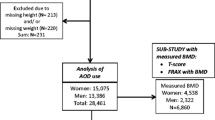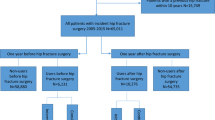Abstract
Summary
This study aims to find predictors of anti-osteoporosis drug (AOD) use. Known risk factors of osteoporosis, i.e., age, hip fracture, and corticosteroid use were found to be predictors of AOD use, in addition to a number of other drugs used. Higher socioeconomic position did not favor the use of AOD.
Introduction
This study deals with studying predictors of anti-osteoporosis drug treatment in Norwegian women and men.
Methods
All Norwegian women and men ≥50 years were included (n = 1,407,392). Data were taken from different data sources, (1) the Norwegian Prescription Database (drug use in 2004–2005); (2) the Nationwide Census 2001 (marital status, education and resident county); (3) the National Hip Fracture Database (hip fractures 2003–2005); and (4) the National Population Register (date of death/emigration). We estimated the hazard ratios (HR) for incident treatment by Cox proportional hazard regression.
Results
In 2005, 10,332 women (1.5 %) and 1,387 men (0.2 %) were new users of anti-osteoporosis drugs (incident treatment). Age was a statistically significant predictor of incident treatment in both women and men, with HR ranging from 1.7 to 3.2 (per 10 years). A middle educational level in men strongly predicted incident treatment [HR 2.0 (CI 1.1–3.8)], but not in women after full adjustment. A previous hip fracture, increasing number of drugs used and use of corticosteroids were all predictors of incident treatment in both genders after adjustments. Corticosteroid use [HRwomen = 4.0 (CI 3.8–4.2)] had a higher HR for incident treatment than hip fracture [HRwomen = 2.0 (CI 1.8–2.3)]. Marital status and area of residency were not predictors of incident treatment in either gender, after adjustments. The predictors of prevalent treatment were only slightly different from incident treatment in 2005.
Conclusions
Age, previous hip fracture, number of drugs used, and use of corticosteroids were positively related to treatment in both genders. In men, a middle educational level predicted treatment.

Similar content being viewed by others
References
Falch JA, Meyer HE (1998) Osteoporosis and fractures in Norway. Occurrence and risk factors. Tidsskr Nor Laegeforen 118:568–572
Lofthus CM, Osnes EK, Falch JA, Kaastad TS, Kristiansen IS, Nordsletten L, Stensvold I, Meyer HE (2001) Epidemiology of hip fractures in Oslo, Norway. Bone 29:413–418
Lunt M, Felsenberg D, Adams J, Benevolenskaya L, Cannata J, Dequeker J, Dodenhof C, Falch JA, Johnell O, Khaw KT, Masaryk P, Pols H, Poor G, Reid D, Scheidt-Nave C, Weber K, Silman AJ, Reeve J (1997) Population-based geographic variations in DXA bone density in Europe: the EVOS Study. European Vertebral Osteoporosis. Osteoporos Int 7:175–189
O’Neill TW, Felsenberg D, Varlow J, Cooper C, Kanis JA, Silman AJ (1996) The prevalence of vertebral deformity in European men and women: the European Vertebral Osteoporosis Study. J Bone Miner Res 11:1010–1018
Boonen S, Autier P, Barette M, Vanderschueren D, Lips P, Haentjens P (2004) Functional outcome and quality of life following hip fracture in elderly women: a prospective controlled study. Osteoporos Int 15:87–94
Cooper C (1997) The crippling consequences of fractures and their impact on quality of life. Am J Med 103:12S–17S
Forsen L, Sogaard AJ, Meyer HE, Edna T, Kopjar B (1999) Survival after hip fracture: short- and long-term excess mortality according to age and gender. Osteoporos Int 10:73–78
Johnell O, Kanis JA, Jonsson B, Oden A, Johansson H, De LC (2005) The burden of hospitalised fractures in Sweden. Osteoporos Int 16:222–228
Osnes EK, Lofthus CM, Meyer HE, Falch JA, Nordsletten L, Cappelen I, Kristiansen IS (2004) Consequences of hip fracture on activities of daily life and residential needs. Osteoporos Int 15:567–574
Johnell O, Kanis JA (2006) An estimate of the worldwide prevalence and disability associated with osteoporotic fractures. Osteoporos Int 17:1726–1733
Bliuc D, Ong CR, Eisman JA, Center JR (2005) Barriers to effective management of osteoporosis in moderate and minimal trauma fractures: a prospective study. Osteoporos Int 16:977–982
Eisman J, Clapham S, Kehoe L, Australian BS (2004) Osteoporosis prevalence and levels of treatment in primary care: the Australian BoneCare Study. J Bone Miner Res 19:1969–1975
Colon-Emeric C, Lyles KW, Levine DA, House P, Schenck A, Gorospe J, Fermazin M, Oliver K, Alison J, Weisman N, Xie A, Curtis JR, Saag K (2007) Prevalence and predictors of osteoporosis treatment in nursing home residents with known osteoporosis or recent fracture. Osteoporos Int 18:553–559
Luthje P, Nurmi-Luthje I, Kaukonen JP, Kuurne S, Naboulsi H, Kataja M (2009) Undertreatment of osteoporosis following hip fracture in the elderly. Arch Gerontol Geriatr 49:153–157
Panneman MJ, Lips P, Sen SS, Herings RM (2004) Undertreatment with anti-osteoporotic drugs after hospitalization for fracture. Osteoporos Int 15:120–124
Solomon DH, Morris C, Cheng H, Cabral D, Katz JN, Finkelstein JS, Avorn J (2005) Medication use patterns for osteoporosis: an assessment of guidelines, treatment rates, and quality improvement interventions. Mayo Clin Proc 80:194–202
Devold HM, Doung GM, Tverdal A, Furu K, Meyer HE, Falch JA, Sogaard AJ (2010) Prescription of anti-osteoporosis drugs during 2004–2007—a nationwide register study in Norway. Eur J Clin Pharmacol 66:299–306
Sosial- og helsedirektoratet (2005) Faglige retningslinjer for forebygging og behandling av osteoporose og osteoporotiske brudd. Sosial-og helsedirektoratet, Oslo
Asche C, Nelson R, McAdam-Marx C, Jhaveri M, Ye X (2010) Predictors of oral bisphosphonate prescriptions in post-menopausal women with osteoporosis in a real-world setting in the USA. Osteoporos Int 21:1427–1436
Cranney A, Tsang JF, Leslie WD (2009) Factors predicting osteoporosis treatment initiation in a regionally based cohort. Osteoporos Int 20:1621–1625
Onder G, Pedone C, Gambassi G, Landi F, Cesari M, Bernabei R (2001) Treatment of osteoporosis among older adults discharged from hospital in Italy. Eur J Clin Pharmacol 57:599–604
Furu K, Wettermark B, Andersen M, Martikainen JE, Almarsdottir AB, Sorensen HT (2010) The Nordic countries as a cohort for pharmacoepidemiological research. Basic Clin Pharmacol Toxicol 106:86–94
WHO Collaborating Centre for Drug Statistics Methodology (2009) Guildelines for ATC classification and DDD assignment 2009. Norwegian Institute of Public Health, Oslo
NOREPOS—The Norwegian Epidemiologic Osteoporosis Studies. www.norepos.no. Accessed 16 Aug 2011
Statistics Norway. Population and housing census 2001. http://www.ssb.no/fob_en/. Accessed 22 Sept 2009
The Norwegian prescription database. http://www.norpd.no/. Accessed 1 Nov 2009
Statistics Norway. Education register. http://www.ssb.no/english/subjects/04/01/utniv_en/. Accessed 25 Aug 2009
Statistics Norway. StatBank Norway. http://statbank.ssb.no/statistikkbanken/. Accessed 6 Sept 2011
Roerholt C, Eiken P, Abrahamsen B (2009) Initiation of anti-osteoporotic therapy in patients with recent fractures: a nationwide analysis of prescription rates and persistence. Osteoporos Int 20:299–307
Cadarette SM, Katz JN, Brookhart MA, Levin R, Stedman MR, Choudhry NK, Solomon DH (2008) Trends in drug prescribing for osteoporosis after hip fracture, 1995–2004. J Rheumatol 35:319–326
Beaupre LA, Morrish DW, Hanley DA, Maksymowych WP, Bell NR, Juby AG, Majumdar SR (2011) Oral bisphosphonates are associated with reduced mortality after hip fracture. Osteoporos Int 22:983–991
Maggi S, Siviero P, Gonnelli S, Caffarelli C, Gandolini G, Cisari C, Rossini M, Iolascon G, Mauro GL, Nuti R, Crepaldi G (2011) The burden of previous fractures in hip fracture patients. The Break Study. Aging Clin Exp Res 23:183–186
McLellan AR, Wolowacz SE, Zimovetz EA, Beard SM, Lock S, McCrink L, Adekunle F, Roberts D (2011) Fracture liaison services for the evaluation and management of patients with osteoporotic fracture: a cost-effectiveness evaluation based on data collected over 8 years of service provision. Osteoporos Int 22:2083–2098
Compston J, Cooper A, Cooper C, Francis R, Kanis JA, Reid DM, Selby P, Wilkins M (2010) Guideline for the diagnosis and management of osteoporosis in postmenopausal women and men of 50 years in the UK. National Osteoporosis Guideline Group (NOGG)
Kanis JA, Burlet N, Cooper C, Delmas PD, Reginster JY, Borgstrom F, Rizzoli R (2008) European guidance for the diagnosis and management of osteoporosis in postmenopausal women. Osteoporos Int 19:399–428
Varenna M, Binelli L, Zucchi F, Ghiringhelli D, Gallazzi M, Sinigaglia L (1999) Prevalence of osteoporosis by educational level in a cohort of postmenopausal women. Osteoporos Int 9:236–241
Cadarette SM, Gignac MA, Jaglal SB, Beaton DE, Hawker GA (2007) Access to osteoporosis treatment is critically linked to access to dual-energy X-ray absorptiometry testing. Med Care 45:896–901
Brask-Lindemann D, Cadarette SM, Eskildsen P, Abrahamsen B (2011) Osteoporosis pharmacotherapy following bone densitometry: importance of patient beliefs and understanding of DXA results. Osteoporos Int 22:1493–1501
Acknowledgments
We would like to thank Electrical Engineer and System Architect Tomislav Dimoski at the Norwegian Knowledge Centre for the Health Services who developed the system which enabled extraction and transfer of data from the hospital’s patient administrative systems. He and his team also carried through the collection of the hip fracture data. The staffs at the Department of Pharmacoepidemiology, the Norwegian Institute of Public Health (NIPH) and our collaborators at Statistics Norway deserve appreciation for assisting in transferring the hip fracture data to the NIPH and in the encryption process. Thanks are also given to post doc Kristin Holvik, post doc Tone M. Omsland and senior advisor Dominic A. Hoff at the NIPH for their thorough and substantial task with quality control of the hip fracture data.
Conflicts of interest
None.
Author information
Authors and Affiliations
Corresponding author
Rights and permissions
About this article
Cite this article
Devold, H.M., Søgaard, A.J., Tverdal, A. et al. Hip fracture and other predictors of anti-osteoporosis drug use in Norway. Osteoporos Int 24, 1225–1233 (2013). https://doi.org/10.1007/s00198-012-2063-1
Received:
Accepted:
Published:
Issue Date:
DOI: https://doi.org/10.1007/s00198-012-2063-1




